一文带你学习SpringBoot
产生背景:Spring开发比较繁琐,配置文件很多,部署流程复杂,整合第三方框架难度大。这会降低开发效率
SpringBoot是一个简化Spring应用创建和开发的框架
整合了整个Spring技术栈,是JavaEE开发一站式解决方案
2.为什么使用SpringBoot
优点:
- 可以快速构架Spring项目,并与主流框架进行集成
- 内置Servlet容器,不需要手动部署war包
- 使用starter管理依赖并进行版本控制
- 大量自动配置,简化开发
- 提供准生产环境的运行时监控
- 不需要XML文件
二、第一个SpringBoot程序
1.操作步骤
步骤:
1.1 创建一个Maven的jar工程
传统的应用需要创建web工程,然后将应用打成war包,然后部署在容器中
而SpringBoot只需要打成一个jar包,其中内置了tomcat
1.2 导入SpringBoot相关依赖
<?xml version="1.0" encoding="UTF-8"?>
<project xmlns="http://maven.apache.org/POM/4.0.0" xmlns:xsi="http://www.w3.org/2001/XMLSchema-instance"
xsi:schemaLocation="http://maven.apache.org/POM/4.0.0 http://maven.apache.org/xsd/maven-4.0.0.xsd">
<modelVersion>4.0.0</modelVersion>
<groupId>com.ly</groupId>
<artifactId>springboot01-helloworld</artifactId>
<version>1.0-SNAPSHOT</version>
<parent>
<groupId>org.springframework.boot</groupId>
<artifactId>spring-boot-starter-parent</artifactId>
<version>2.1.9.RELEASE</version>
</parent>
<name>springboot01-helloworld</name>
<!-- FIXME change it to the project's website -->
<url>http://www.example.com</url>
<properties>
<project.build.sourceEncoding>UTF-8</project.build.sourceEncoding>
<maven.compiler.source>1.8</maven.compiler.source>
<maven.compiler.target>1.8</maven.compiler.target>
</properties>
<dependencies>
<dependency>
<groupId>junit</groupId>
<artifactId>junit</artifactId>
<version>4.11</version>
<scope>test</scope>
</dependency>
<dependency>
<groupId>org.springframework.boot</groupId>
<artifactId>spring-boot-starter-web</artifactId>
</dependency>
</dependencies>
<build>
</build>
</project>
复制代码
1.3 创建Controller
package com.ly.controller;
import org.springframework.stereotype.Controller;
import org.springframework.web.bind.annotation.RequestMapping;
import org.springframework.web.bind.annotation.ResponseBody;
/**
* Author: LuYi
* Date: 2019/10/27 11:05
* Description: 描述
*/
@Controller
public class HelloController {
@RequestMapping("/hello")
@ResponseBody
public String hello(){
return "Hello World";
}
}
复制代码
1.4 创建启动类
package com.ly;
import org.springframework.boot.SpringApplication;
import org.springframework.boot.autoconfigure.SpringBootApplication;
/**
* Author: LuYi
* Date: 2019/10/27 11:05
* Description: 使用@SpringBootApplication将类标注成SpringBoot应用
*/
@SpringBootApplication
public class App {
public static void main(String[] args) {
SpringApplication.run(App.class, args);
}
}
复制代码
默认会扫描 @SpringBootApplication 注解所在的包及其子包,也可使用 @ComponentScan("com.ly.controller") 注解进行指定
1.5 打包
<!--该插件可以将应用打包成一个可执行的jar包-->
<build>
<plugins>
<plugin>
<groupId>org.springframework.boot</groupId>
<artifactId>spring-boot-maven-plugin</artifactId>
</plugin>
</plugins>
</build>
复制代码
添加该插件,将应用打成可执行的jar包, 执行: java -jar jar文件
2. 分析HelloWorld
2.1 POM文件
-
父工程
<parent> <groupId>org.springframework.boot</groupId> <artifactId>spring-boot-starter-parent</artifactId> <version>2.1.9.RELEASE</version> </parent> 复制代码 -
父工程的父工程:用来管理SpringBoot应用中依赖的版本,进行版本控制
<parent> <groupId>org.springframework.boot</groupId> <artifactId>spring-boot-dependencies</artifactId> <version>2.1.9.RELEASE</version> <relativePath>../../spring-boot-dependencies</relativePath> </parent> 复制代码 -
依赖:通过
starter指定依赖<dependency> <groupId>org.springframework.boot</groupId> <artifactId>spring-boot-starter-web</artifactId> </dependency> 复制代码SpringBoot提供了很多starter(启动器),分别对应了不同的应用场景,当在项目中引入这些starter时,相应场景的依赖就会被导入进来
2.2 启动类
@Target({ElementType.TYPE})
@Retention(RetentionPolicy.RUNTIME)
@Documented
@Inherited
@SpringBootConfiguration
@EnableAutoConfiguration
@ComponentScan(
excludeFilters = {@Filter(
type = FilterType.CUSTOM,
classes = {TypeExcludeFilter.class}
), @Filter(
type = FilterType.CUSTOM,
classes = {AutoConfigurationExcludeFilter.class}
)}
)
复制代码
-
@SpringBootApplication
标注在类上,表示这个类是SpringBoot的启动类,通过该类的Main方法启动SpringBoot应用
-
@SpringBootConfiguration
标注在类上,表示这个类是SpringBoot的配置类
层级关系:SpringBootConfiguration——>@Configuration——>@Component
@Configuration:标注在类上,表示这个类是Spring的配置类,相当于XML配置文件
-
@EnableAutoConfiguration
开启 自动配置 功能,简化了以前繁琐的配置
SpringBoot在启动时会在/META-INF/spring.factories中EnableAutoConfiguration指定的值,将这些值作为自动配置类添加到容器中,这些 自动配置类 会帮我们完成很多配置工作。
-
@ComponentScan
标注在类上,指定要扫描的包及其子包
三、快速创建SpringBoot项目
1.简介
使用Spring initializer快速构建SpringBoot项目
2. 基本操作
-
pom文件和主程序类自动生成,直接写业务逻辑即可
-
resources文件夹的目录结构
|-static 存放静态资源,如js,css,images |-template 存放模板引擎,如freemarker、thymeleaf等 |-application.properties SpringBoot应用的配置文件,可以修改默认设置 复制代码
四、配置文件
1.简介
SpringBoot的默认全局配置文件有两种:
- application.properties
- application.yml
文件名固定,存放在classpath:/或classpath:/config/目录下
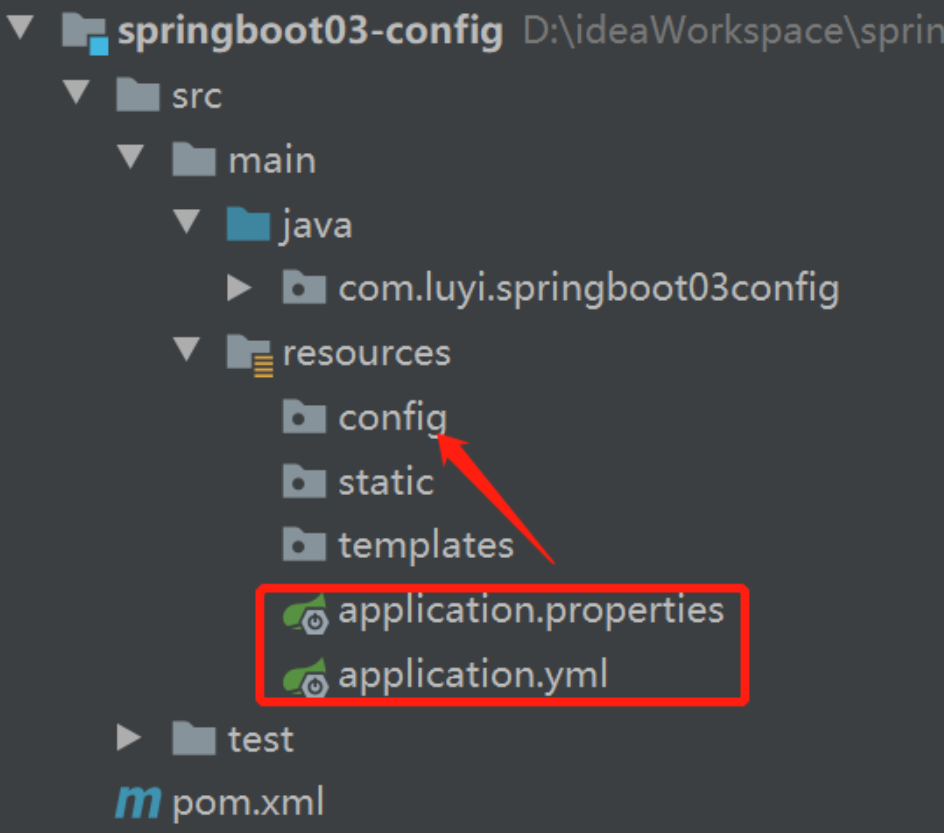
可以修改Spring Boot默认配置,具体参考: docs.spring.io/spring-boot…
注意:SpringBoot2.0和1.0的配置有区别,有的配置项已被删除
2.YAML用法
2.1 简介
YAML不是一种标记语言,YAML是专门用来写配置文件的,它以数据为中心,简介强大,比xml和properties更适合做配置文件
YAML文件以.yml或.yaml为后置名
2.2 application.yml
server:
port: 8081 #写法:key: value 冒号后面必须有空格
servlet:
context-path: /springboot03/
复制代码
2.3 语法规则
#
2.4 基本用法
YAML支持的数据结构有三种:
- 字面量:单个的,不可再分的值(字符串、数字、boolean值)
- 对象:键值对集合
- 数组:一组按次序排列的值
三种数据结构的用法:
1.字面量:普通的值,如数字、字符串、布尔值
number: 12.5 str: hello name: 'tom cruise' #如字符串包含空格及特殊字符需要使用 引号 引起来 name: 'tom /n cruise' #不会对特殊字符进行转义 结果为:tom 换行 cruise name: "tom /n cruise" #对特殊字符进行转义,会作为普通字符输出, 结果为 tom /n cruise 复制代码
-
对象,也成为映射Map,包含属性和值
# 写法1:换行写 user: name: tom age: 20 sex: male # 写法2:行内写法 user: {name: tom, age: 20, sex: male} 复制代码- 数组,如List、Set等
# 写法1: 一组短横线开头的行 names: - tom - jack - alice # 写法2: 行内写法 name: {tom,jack,alice} 复制代码
3. 为属性注入值
通过加载配置文件,为类中的属性注入值
3.1 编写application.yml
user:
username: admin
age: 21
status: true
birthday: 2019/2/14
address:
province: 黑龙江省
city: 哈尔滨市
lists:
- list1
- list2
- list3
maps: {k1: v1,k2: v2}
复制代码
3.2 创建实体类
User
package com.luyi.bean;
import org.springframework.boot.context.properties.ConfigurationProperties;
import org.springframework.stereotype.Component;
import java.util.Date;
import java.util.List;
import java.util.Map;
/**
* Author: LuYi
* Date: 2019/10/27 13:49
* Description: 通过加载配置文件为当前类中的属性注入值
*/
// 必须将当前类加入到容器
@Component
// 默认读取全局配置文件获取值,当前类中的所有属性与 user 进行绑定
@ConfigurationProperties(value = "user")
public class User {
private String username;
private Integer age;
private Boolean status;
private Date birthday;
private Address address;
private List<String> lists;
private Map<String, Object> maps;
public String getUsername() {
return username;
}
public void setUsername(String username) {
this.username = username;
}
public Integer getAge() {
return age;
}
public void setAge(Integer age) {
this.age = age;
}
public Boolean getStatus() {
return status;
}
public void setStatus(Boolean status) {
this.status = status;
}
public Date getBirthday() {
return birthday;
}
public void setBirthday(Date birthday) {
this.birthday = birthday;
}
public Address getAddress() {
return address;
}
public void setAddress(Address address) {
this.address = address;
}
public List<String> getLists() {
return lists;
}
public void setLists(List<String> lists) {
this.lists = lists;
}
public Map<String, Object> getMaps() {
return maps;
}
public void setMaps(Map<String, Object> maps) {
this.maps = maps;
}
@Override
public String toString() {
return "User{" +
"username='" + username + '/'' +
", age=" + age +
", status=" + status +
", birthday=" + birthday +
", address=" + address +
", lists=" + lists +
", maps=" + maps +
'}';
}
}
复制代码
Address
package com.luyi.bean;
/**
* Author: LuYi
* Date: 2019/10/27 13:50
* Description: 描述
*/
public class Address {
private String province;
private String city;
public String getProvince() {
return province;
}
public void setProvince(String province) {
this.province = province;
}
public String getCity() {
return city;
}
public void setCity(String city) {
this.city = city;
}
@Override
public String toString() {
return "Address{" +
"province='" + province + '/'' +
", city='" + city + '/'' +
'}';
}
}
复制代码
3.3 测试
package com.luyi.springboot03config;
import com.luyi.bean.User;
import org.junit.jupiter.api.Test;
import org.springframework.beans.factory.annotation.Autowired;
import org.springframework.boot.test.context.SpringBootTest;
@SpringBootTest
class Springboot03ConfigApplicationTests {
@Autowired
private User user;
@Test
void contextLoads() {
System.out.println(user);
}
}
复制代码
3.4 添加配置文件处理器依赖(可选)
<!--配置文件处理器,自动生成元数据信息,编写配置文件会有提示-->
<dependency>
<groupId>org.springframework.boot</groupId>
<artifactId>spring-boot-configuration-processor</artifactId>
<optional>true</optional>
</dependency>
复制代码
3.5 使用properties配置文件
user.username=alice user.age=22 user.status=false user.birthday=2019/10/27 user.address.province=黑龙江省 user.address.city=哈尔滨 user.lists=list1,list2,list3 user.maps.k1=v1 user.maps.k2=v2 复制代码
注意:在IDEA中默认使用UTF-8编码,properties文件默认使用ASCII编码,所以会出现乱码,可通过勾选解决
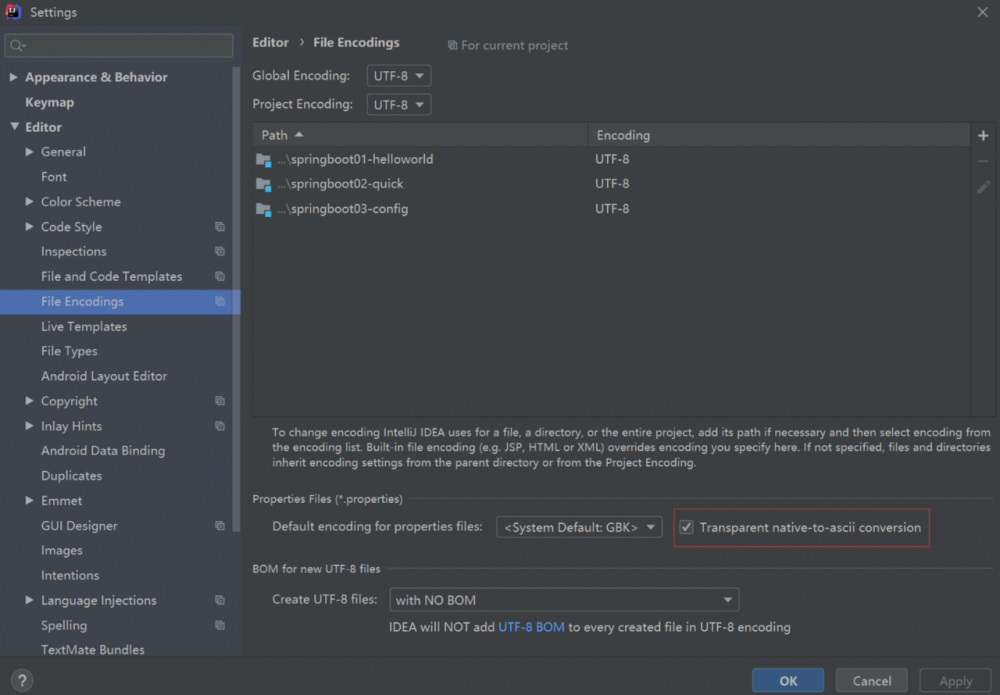
优先级:properties > yml
3.6 使用@Value注解注入值
@Value("${user.username}")
private String username;
@Value("${user.age}")
private Integer age;
@Value("${user.status}")
private Boolean status;
@Value("${user.birthday}")
private Date birthday;
//@Value不支持复杂类型封装
private Address address;
@Value("${user.lists}")
private List<String> lists;
private Map<String, Object> maps;
复制代码
@Value与@ConfigurationProperties比较:
- 前者只可以单值注入,后者可以批量注入
- 前者不支持为复杂类型封装,后者支持
4.多环境配置
可以为不同环境提供不同配置信息,如开发环境、测试环境、生产环境等
两种方式:
- 创建多个properties文件
- 定义yml文档块
4.1 创建多个properties文件
步骤:
1.创建不同环境的properties文件
文件命名必须符合aplication-xxx.properties的格式
application-dev.properties
server.port=9991 复制代码
application-test.properties
server.port=9992 复制代码
application-prod.properties
server.port=9993 复制代码
2.在application.properties中指定需要激活的配置
#指定要激活的配置 spring.profiles.active=prod 复制代码
4.2 定义yml文档块
1.在yml中使用三个短横线定义多个文档块
spring: profiles: dev server: port: 9991 --- spring: profiles: test server: port: 9992 --- spring: profiles: prod server: port: 9993 复制代码
2.在第一个文档块指定要激活的环境
spring:
profiles:
active: test
---
复制代码
5.加载外部配置文件
5.1 加载properties属性文件
问题:@ConfigurationProperties默认是从全局配置文件中读取值,如果想自定义属性文件中获取值怎么办?
解决:使用@PropertySource注解加载外部属性文件
// 必须将当前类加入到容器
@Component
//加载外部的属性文件
@PropertySource({"classpath:user.properties"})
// 默认读取全局配置文件获取值,当前类中的所有属性与 user 进行绑定
@ConfigurationProperties(value = "user")
public class User{
复制代码
5.2 加载spring配置文件
问题:如果有信息需要写道xml文件中,想加载xml文件怎么办
解决:使用@ImportResource加载外部配置文件
5.3 使用注解方式添加组件
推荐使用全注解方式向Spring容器添加组件,@Configuration和@Bean
/**
* Author: LuYi
* Date: 2019/10/28 14:49
* Description: 描述
*/
//添加在类上,表示这个类是一个配置类,相当于spring配置文件
@Configuration
public class SpringConfig {
//标注在方法上,用来向容器中添加组件,将方法的返回值添加到容器中,方法名作为bean的id
@Bean
public Address address(){
Address address = new Address();
address.setProvince("山东");
address.setCity("日照");
return address;
}
}
复制代码
五、SpringBoot自动配置原理
1.执行流程
1.SpringBoot启动时加载主配置类,使用@EnableAutoConfiguration开启了自动配置功能
2.@EnableAutoConfiguration中使用了 @Import({AutoConfigurationImportSelector.class})向容器中添加了一些组件(自动配置类)
查看AutoConfigurationImportSelector类中的selectImports方法,再点击getAutoConfigurationEntry方法中的`getCandidateConfigurations方法
通过getCandidateConfigurations中的loadFactoryNames方法加载到SpringFactory,
再通过classLoader加载 META-INF/spring.factories 的配置,从配置中获取EnableAutoConfiguration(spring-boot-autoconfigure-2.1.9.RELEASE.jar)对应的值。
将这些自动配置类(xxxAutoConfiguration)添加到容器中
3.通过自动配置类完成自动配置功能。
2. 原理分析
以HttpEncodingAutoConfiguration为例,就是以前在web.xml中配置的CharacterEncodingFilter过滤器
//表示这是一个配置类,相当于以前编写的Spring配置文件
@Configuration
//启用HttpProperties类的ConfigurationProperties功能,通过配置文件为属性注入值,并将其添加到容器中
@EnableConfigurationProperties({HttpProperties.class})
//当该应用是web应用时才生效
@ConditionalOnWebApplication(
type = Type.SERVLET
)
//必须包含CharacterEncodingFilter类才生效
@ConditionalOnClass({CharacterEncodingFilter.class})
//如果配置文件中有spring.http.encoding选项则该配置生效,否则不生效。但是默认已经生效了
@ConditionalOnProperty(
prefix = "spring.http.encoding",
value = {"enabled"},
matchIfMissing = true
)
public class HttpEncodingAutoConfiguration {
private final Encoding properties;
//将容器中的HttpProperties注入
public HttpEncodingAutoConfiguration(HttpProperties properties) {
this.properties = properties.getEncoding();
}
//将返回的filter添加到容器中,作为bean
@Bean
//如果容器中没有这个bean才会生效
@ConditionalOnMissingBean
public CharacterEncodingFilter characterEncodingFilter() {
CharacterEncodingFilter filter = new OrderedCharacterEncodingFilter();
filter.setEncoding(this.properties.getCharset().name());
filter.setForceRequestEncoding(this.properties.shouldForce(org.springframework.boot.autoconfigure.http.HttpProperties.Encoding.Type.REQUEST));
filter.setForceResponseEncoding(this.properties.shouldForce(org.springframework.boot.autoconfigure.http.HttpProperties.Encoding.Type.RESPONSE));
return filter;
}
复制代码
//从配置文件中获取指定的值,然后绑定到指定的属性值
@ConfigurationProperties(
prefix = "spring.http"
)
public class HttpProperties {
private Charset charset;
private Boolean force;
private Boolean forceRequest;
private Boolean forceResponse;
private Map<Locale, Charset> mapping;
复制代码
注意:
- 根据当前情况进行判断,决定配置类是否生产,如果不满足条件自动配置就不会生效
- 自动配置类xxAutoConfiguration的属性是从对应的xxProperties类中获取
- xxProperties类中的信息是通过配置文件注入绑定的,可以通过配置文件指定属性的值
3.总结
- SpringBoot在启动时会加载大量的自动配置类
- 通过自动配置了向容器中添加组件
- 通过这些组件自动完成许多功能,从而简化配置
可以通过开启debug模式查看自动配置类的匹配情况
#开启debug模式 debug=true 复制代码
六、Web开发
1.简介
使用SpringBoot开发Web应用的步骤:
1.创建SpringBoot项目,添加对应的starter
2.在配置文件中指定必要的少量配置
3.编写业务代码
Web开发的自动配置类WebMvcAutoConfiguration
2.关于静态资源的映射
2.1 静态资源的位置
查看WebMvcAutoConfiguration——>addResourceHandlers()——>getStaticLocations()——>staticLocations
静态资源的默认位置
"classpath:/META-INF/resources/", "classpath:/resources/", "classpath:/static/", "classpath:/public/" 复制代码
可以通过上面的文件夹可以访问到静态资源
也可以在配置文件中自己指定可以访问的位置
# 指定静态资源的位置 存放在根目录下的public文件夹中 spring.resources.static-locations=classpath:/public 复制代码
2.2 欢迎页
查看WebMvcAutoConfiguration—>welcomePageHandlerMapping()—>getWelcomePage()
将index.html页面放到任意一个静态资源文件夹中的
2.3 网站图标
查看WebMvcAutoConfiguration—>内部类FaviconConfiguration—>faviconHandlerMapping
将favicon.ico放到静态资源的任意文件夹中即可
七、模板引擎
1.简介
目前Java Web开发推荐使用模板引擎,不建议使用jsp页面
- jsp的缺点:本质时Servlet,需要后台进行编译,效率较低
- 模板引擎:不需要编译,速度快
常用的模板引擎:Freemarker、Thymeleaf等
SpringBoot推荐Thymeleaf,且默认不支持jsp,因为jsp必须要打成war包。
补充:目前主流的web开发更推荐前后端分离,前端使用MVVM框架,Vue.js、Angular、React等
2.Thymeleaf的使用
步骤:
1.添加Thymeleaf的依赖
<dependency>
<groupId>org.springframework.boot</groupId>
<artifactId>spring-boot-starter-thymeleaf</artifactId>
</dependency>
复制代码
2.将html页面放到templates下
templates下的html不能直接访问,需要使用Controller跳转,由Thymeleaf进行渲染
ThymeleafAutoConfiguration—>ThymeleafProperties
public static final String DEFAULT_PREFIX = "classpath:/templates/"; public static final String DEFAULT_SUFFIX = ".html"; 复制代码
默认拼接前缀和后缀
3.使用thymeleaf
<!DOCTYPE html>
<html lang="en" xmlns:th="http://www.w3.org/1999/xhtml">
<head>
<meta charset="UTF-8">
<title>Title</title>
</head>
<body>
<h2>success</h2>
<!--使用th:text属性设置元素中的文本,表达式:${}可以获取作用域中的数据-->
<p th:text="${name}"></p>
</body>
</html>
复制代码
4.修改页面后,让其实时生效
由于thymeleaf默认启用了缓存,将缓存禁用掉
#禁用thymeleaf的缓存 spring.thymeleaf.cache=false 复制代码
补充:还需要开启idea的自动编译,idea默认保存时不会自动编译
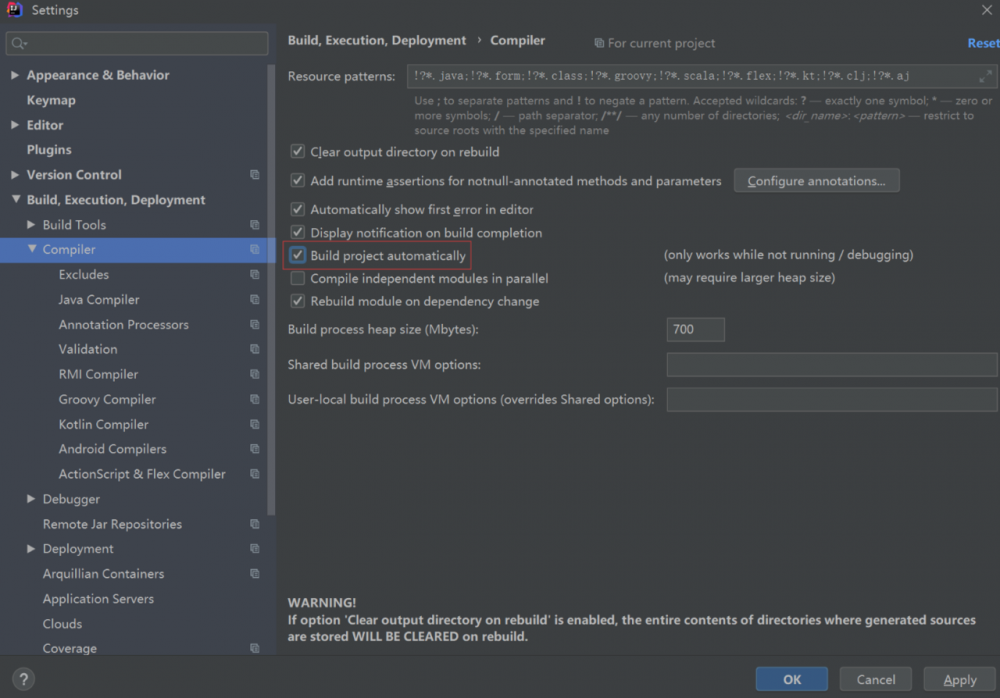
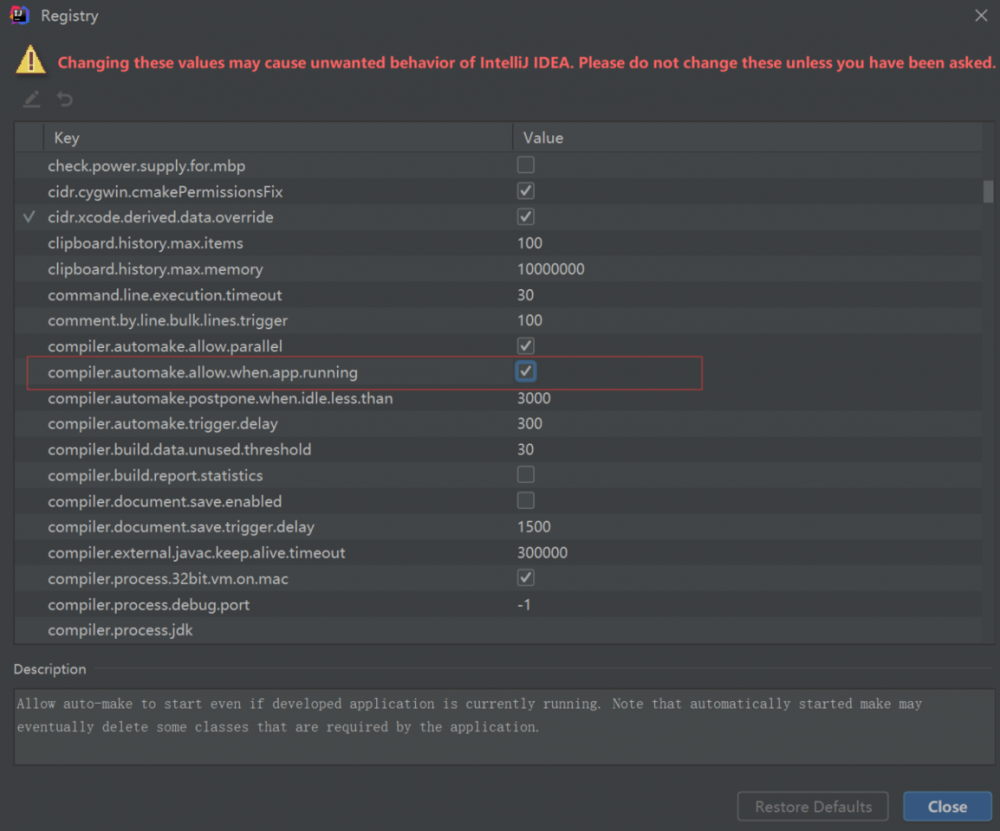
3.语法规则
3.1 常用属性
-
th:text、th:utext
设置元素中的文本内容
th:text对特殊字符进行转义,等价于内联方式[[${ }]]
th:utext不对特殊字符集进行转义,等价于内联方式[(${ })]
<!DOCTYPE html> <html lang="en" xmlns:th="http://www.w3.org/1999/xhtml"> <head> <meta charset="UTF-8"> <title>Title</title> </head> <body> <!--th:text、th:utext--> <div th:text="${hello}">aaa</div> <div th:utext="${hello}">bbb</div> <!--使用内联方式,可以在文本前后添加内容--> <div>[[${hello}]]aaa</div> <div>[(${hello})]bbb</div> </body> </html> 复制代码 -
th:html原生属性
用来替换指定的html原生属性的值
@RequestMapping("/test2") public String test2(Model model){ model.addAttribute("hello", "<mark>你好</mark>"); model.addAttribute("id", "mydiv"); model.addAttribute("title", "this is a div"); return "result"; } 复制代码<!--th:html原生属性--> <div id="div1" title="这是一个div" th:id="${id}" th:title="${title}">div</div> 复制代码 -
th:if、th:unless、th:switch、th:case
条件判断,类似于if
<!--th:if、th:unless、th:switch、th:case--> <div th:if="${age>=18}">成年</div> <p th:unless="${age<18}">成年</p> <p th:switch="${role}"> <span th:case="student">学生</span> <span th:case="teacher">老师</span> <span th:case="*">其他</span> </p> <hr> 复制代码 -
th:each
循环,类似于for each
<!--th:each--> <ul> <li th:each="name:${names}" th:text="${name}"></li> </ul> 复制代码 -
th:object、th:field
用于表单数据对象的绑定,将表单绑定到Controller的一个JavaBean参数,常与th:field
一起使用,需要和*{}选择表达式配合使用
<!--th:object、th:field--> <h2>修改用户信息</h2> <!--th:object指定对象,th:field指定属性--> <form action="modify" method="post" th:object="${user}"> 编号:<input type="text" th:field="*{id}" readonly> <br> 姓名:<input type="text" th:field="*{name}"> <br> 年龄:<input type="text" th:field="*{age}"> <br> <input type="submit" value="修改"> </form> 复制代码 -
th:fragment
声明代码片段,常用于页面头部和尾部的引入
<!--th:fragment--> <header th:fragment="head"> 这是页面的头部,导航 </header> 复制代码 -
th:include、th:insert、th:replace
引入代码片段,类似于jsp:include
<!--th:include、th:insert、th:replace--> <!--引入templates/include下的header.html页面中的fragment为head的片段--> <div th:include="include/header::head"></div> 复制代码
三者之间的区别
th:include会保留自己的标签,不要th:fragment的标签(Thymeleaf 3.0 后不推荐使用) th:insert保留自己的标签,也保留th:fragment的标签 th:relpace不保留自己的标签,保留thfragment的标签
3.2 表达式
-
${} 变量表达式
获取对象的属性、方法
<!DOCTYPE html> <html lang="en" xmlns:th="http://www.w3.org/1999/xhtml"> <head> <meta charset="UTF-8"> <title>Title</title> </head> <body> <!--获取对象的属性、方法--> <div th:text="${user.name}"></div> <div th:text="${user['age']}"></div> <div th:text="${users[1].name}"></div> <!--<div th:text="${users.size()}"></div>--> <div>[[${users.size()}]]个</div> </body> </html> 复制代码使用内置的基本对象,如session和application
<!--使用内置基本对象--> <div th:text="${session.sex}"></div> <div th:text="${application.hobby}"></div> 复制代码使用内置的工具对象,如#strings、#dates、#arrays、#lists、#maps等
<!--使用内置的工具对象--> <div th:text="${#strings.startsWith(user.name, 't')}"></div> <div th:text="${#strings.substring(user.name, 0, 2)}"></div> <div th:text="${#strings.length(user.name)}"></div> <div th:text="${#dates.createNow()}"></div> <div th:text="${#dates.create(2018, 10, 14)}"></div> <div th:text="${#dates.format(birthday, 'yyyy-MM-dd HH:mm:ss')}"></div> 复制代码 -
*{} 选择表达式(星号表达式)
<!--*{}选择表达式--> <div th:object="${user}"> <div th:text="*{id}"></div> <div th:text="*{name}"></div> <div th:text="*{age}"></div> </div> 复制代码 -
@{} url表达式
<head> <meta charset="UTF-8"> <title>Title</title> <!--url表达式引入css文件--> <link rel="stylesheet" th:href="@{/css/style.css}"> </head> <!--url表达式--> <a th:href="@{/findUser(name=${user.name})}">查询指定的用户信息</a> <a href="product/list.html" th:href="@{/product/list}">商品列表</a> <script th:src="@{/js/common.js}"></script> 复制代码 -
运算符
eq gt le == != 三目运算符
4.热部署
使用SpringBoot提供的devtools实现热部署
原理:实时监控classpath下文件的变化,如果发生变化自动重启
配置:添加devtools依赖
<dependency>
<groupId>org.springframework.boot</groupId>
<artifactId>spring-boot-devtools</artifactId>
<!--该依赖不传递-->
<optional>true</optional>
</dependency>
复制代码
八、扩展默认的SpringMVC功能
1.简介
以前在SpringMVC中可以通过如下代码进行视图跳转和拦截器:
<mvc:view-controller path="/showLogin" view-name="login"/>
<mvc:interceptors>
<mvc:interceptor>
<mvc:mapping path="/hello"/>
<bean class="com.luyi.interceptor.HelloInterceptor"/>
</mvc:interceptor>
</mvc:interceptors>
复制代码
SpringBoot默认配置默认没有提供以上功能,需要自己扩展,使用WebMvcConfigurer接口
2.基本操作
步骤:
1.定义一个配置类,实现WebMvcConfigurer接口
2.实现需要的方法
/**
* Author: LuYi
* Date: 2019/10/29 17:58
* Description: 扩展默认的SpringMVC的功能
* 要求:
* 1.将该类标记为配置类
* 2.实现WebMvcConfigurer接口
* 3.根据需要实现接口中相应的方法
*
* 注意:这个接口中的方法都添加了jdk1.8中的default方法修饰,不强制实现所有方法(jdk1.8新特性)
* 在SpringBoot1.0中是继承WebMvcConfigurerAdapter类,SpringBoot2.0是基于jdk1.8的,
* 所以通过实现WebMvcConfigurer的方式
*/
//将该类设置为配置类
@Configuration
public class CustomMvcConfig implements WebMvcConfigurer {
//添加ViewController
@Override
public void addViewControllers(ViewControllerRegistry registry) {
//将访问login页面的url设置为showLogin
registry.addViewController("/showLogin").setViewName("login");
}
@Override
public void addInterceptors(InterceptorRegistry registry) {
registry.addInterceptor(new MyInterceptor()).addPathPatterns("/**")
.excludePathPatterns("/test2");
}
}
复制代码
九、全局异常处理
1.简介
当程序出现异常时进行全局处理,SpringBoot默认的异常信息提示: Whitelabel Error Page
两种方式:
- 定义错误码页面
- 定义异常通知
2.定义错误码页面
创建 错误状态码.html 页面,放到templates/error目录中,当发生错误时会自动到该目录下查找对应的错误页面
可以创建如 4xx.html 或 5xx.html 页面,用来匹配所有该类型的错误(会优先进行精确匹配
<!DOCTYPE html>
<html lang="en">
<head>
<meta charset="UTF-8">
<title>Title</title>
</head>
<body>
<h2>5xx错误</h2>
<h3>状态码:[[${status}]]</h3>
<h3>异常消息:[[${message}]]</h3>
<h3>错误提示:[[${error}]]</h3>
<h3>时间戳:[[${timestamp}]]</h3>
</body>
</html>
复制代码
3.定义异常通知
/**
* Author: LuYi
* Date: 2019/10/29 18:45
* Description: 异常通知:用来处理全局异常
*/
@ControllerAdvice
public class ExceptionAdvice {
@ExceptionHandler(ArithmeticException.class)
public String arithmetic(Exception e){
System.out.println("警报:程序出现异常,发短信:" + e.getMessage());
return "error/5xx";
}
@ExceptionHandler(Exception.class)
public String exception(Exception e){
System.out.println("警报:程序出现异常,发邮件:" + e.getMessage());
return "error/5xx";
}
}
复制代码
十、关于Servlet容器
1.简介
SpringBoot中默认内置了Servlet:Tomcat
问题:SpringBoot默认以jar包方式启动内置的Servlet容器,没有web.xml文件,如何注册Servlet三大组件:Servlet、Filter、Listener
解决:通过自定义Servlet配置,使用ServletRegistrationBean、FilterRegistrationBean、ServletListenerRegistrationBean
2.注册Servlet组件
步骤:
1.定义一个配置类
2.自定义一个方法,用来注册组件
/**
* Author: LuYi
* Date: 2019/10/29 19:12
* Description: 自定义Servlet配置
*/
//将该类声明为配置类
@Configuration
public class CustomServletConfig {
//将方法返回值放到Spring容器
@Bean
public ServletRegistrationBean myServlet(){
ServletRegistrationBean<Servlet> registrationBean = new ServletRegistrationBean<>();
//对MyServlet进行注册
registrationBean.setServlet(new MyServlet());
ArrayList<String> urls = new ArrayList<>();
urls.add("/myServlet");
registrationBean.setUrlMappings(urls);
return registrationBean;
}
//注册Filter
@Bean
public FilterRegistrationBean myFilter(){
FilterRegistrationBean<Filter> registrationBean = new FilterRegistrationBean<>();
//注册filter
registrationBean.setFilter(new MyFilter());
registrationBean.addUrlPatterns("/showLogin", "/test1");
return registrationBean;
}
//注册Listener
@Bean
public ServletListenerRegistrationBean myListener(){
ServletListenerRegistrationBean<MyListener> registrationBean = new ServletListenerRegistrationBean<>();
registrationBean.setListener(new MyListener());
return registrationBean;
}
}
复制代码
3.使用外部的Servlet容器
3.1 优缺点
使用内置Servlet容器:
优点:使用简单,将应用打成jar包
缺点:不支持jsp、可定制性不高
使用外部的Servlet容器
优点:支持jsp、可定制性高
缺点:需要将应用打成war包
3.2 操作步骤
步骤:
1.创建一个Maven的war工程
有如下三个变化
1.打包方式变为war
<packaging>war</packaging> 复制代码
2.将内置的tomcat的scope配置为provided
<dependency>
<groupId>org.springframework.boot</groupId>
<artifactId>spring-boot-starter-tomcat</artifactId>
<scope>provided</scope>
</dependency>
复制代码
3.定义了一个SpringBootServletInitializer的子类
/**
* 要求:
* 1.必须继承SpringBootServletInitializer
* 2.重写configure()方法
* 3.调用SpringApplicationBuilder的sources()方法,传入主程序类的
*/
public class ServletInitializer extends SpringBootServletInitializer {
@Override
protected SpringApplicationBuilder configure(SpringApplicationBuilder application) {
return application.sources(Springboot05WarApplication.class);
}
}
复制代码
2.创建web目录的结构
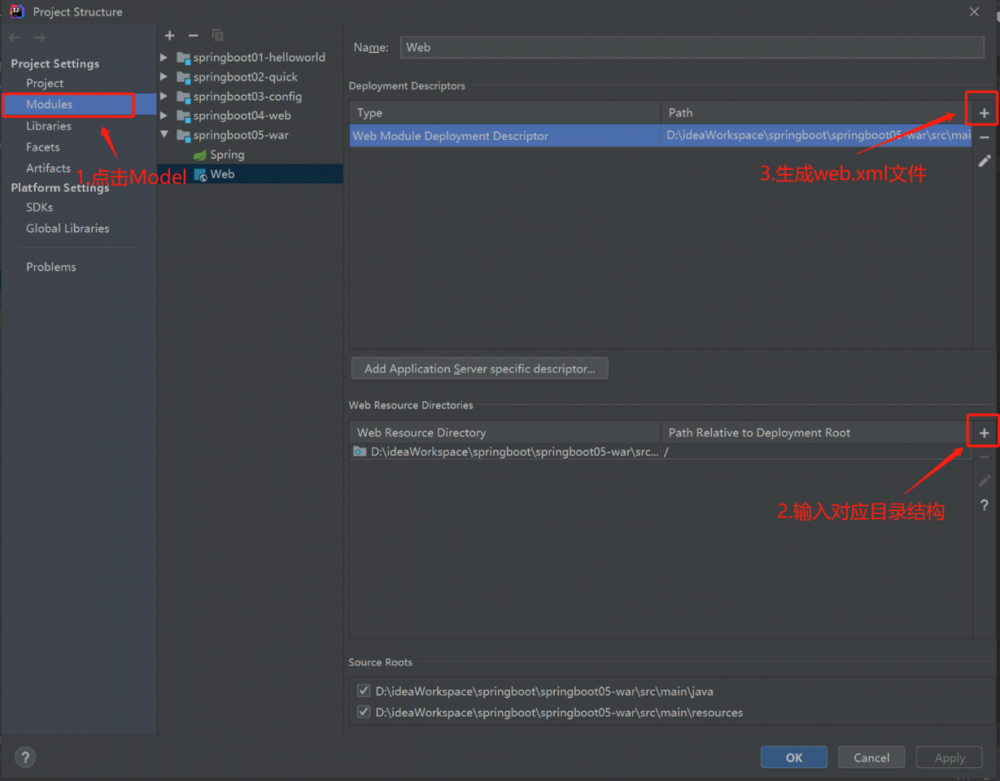
3.配置前缀和后缀
spring.mvc.view.prefix=/WEB-INF/views/ spring.mvc.view.suffix=.jsp 复制代码
4.配置Tomcat
要使用SpringBoot需要的Tomcat版本
十一、SpringBoot数据访问
1.JDBC
步骤:
1.创建工程,选择以下模板:web、jdbc、mysql
2.配置数据库连接信息
#指定数据库连接参数 spring.datasource.driver-class-name= com.mysql.jdbc.Driver spring.datasource.url=jdbc:mysql://localhost:3306/springboot?useUnicode=true&characterEncoding=utf-8&useSSL=false spring.datasource.username=root spring.datasource.password=root #指定数据源 spring.datasource.type=org.apache.commons.dbcp.BasicDataSource 复制代码
3.测试
@RunWith(SpringJUnit4ClassRunner.class)
@SpringBootTest
class Springboot06JdbcApplicationTests {
@Autowired
private DataSource dataSource;
@Test
void contextLoads() throws SQLException {
System.out.println("---------------------------");
System.out.println("DataSource的类型: " + dataSource.getClass());
System.out.println("Connection的连接: " + dataSource.getConnection());
}
}
复制代码
4.配置连接池参数
spring.datasource.initialSize=10 spring.datasource.maxActive=100 spring.datasource.minIdle=5 spring.datasource.maxWait=50000 复制代码
问题:添加上面的参数不生效,因为SpringBoot默认并不支持这些参数(DataSourceProperties)
解决:自定义数据源配置
/**
* Author: LuYi
* Date: 2019/10/30 16:09
* Description: 描述
*/
@Configuration
public class DatasourceConfig {
@Bean
//从配置文件中读取spring.datasource属性,并注入给数据源的属性
@ConfigurationProperties(prefix = "spring.datasource")
public DataSource dataSource(){
return new BasicDataSource();
}
}
复制代码
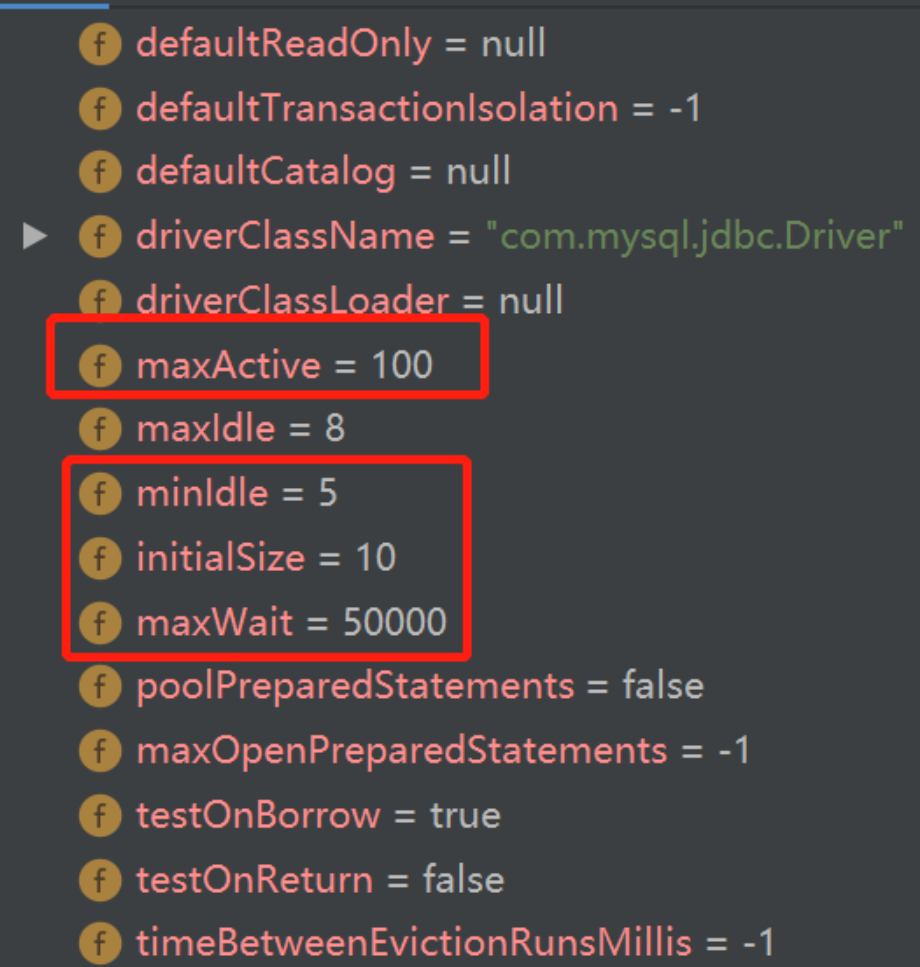
5.使用JdbcTemplate操作数据库
/**
* Author: LuYi
* Date: 2019/10/30 16:17
* Description: 描述
*/
@Controller
@RequestMapping("/user")
public class UserController {
@Autowired
private JdbcTemplate jdbcTemplate;
@RequestMapping("/findAll")
@ResponseBody
public List<Map<String, Object>> findAll(){
String sql = "select * from t_user";
List<Map<String, Object>> list = jdbcTemplate.queryForList(sql);
return list;
}
}
复制代码
2.MyBatis
2.1 基本步骤
1.创建工程,先择以下模块:web、mybatis
2.配置数据源
#配置DataSource
spring:
datasource:
driver-class-name: com.mysql.jdbc.Driver
url: jdbc:mysql://localhost:3306/springboot?useUnicode=true&characterEncoding=utf-8&useSSL=false
username: root
password: root
initialSize: 5
maxActive: 100
minIdle: 3
maxWait: 50000
#配置MyBatis
mybatis:
type-aliases-package: com.luyi.pojo
mapper-locations: classpath:mapper/*.xml
复制代码
3.编写Mapper、Service、Controller
4.配置MyBatisConfig配置类
/**
* Author: LuYi
* Date: 2019/10/30 16:57
* Description: 描述
*/
@Configuration
//扫描MyBatis接口所在的包
@MapperScan("com.luyi.mapper")
public class MyBatisConfig {
@Bean
//加载主配置文件,注入配置信息
@ConfigurationProperties(prefix = "spring.datasource")
public DruidDataSource druidDataSource(){
return new DruidDataSource();
}
}
复制代码
2.2 配置PageHelper分页插件
步骤:
1.添加PageHelper依赖
<dependency>
<groupId>com.github.pagehelper</groupId>
<artifactId>pagehelper-spring-boot-starter</artifactId>
<version>1.2.10</version>
</dependency>
复制代码
2.配置PageHelper的属性
#配置PageHelper pagehelper: helper-dialect: mysql 复制代码
3.使用PageHelper
@Override
public PageInfo<User> findByPage(int pageNum, int pageSize) {
//使用PageHelper设置分页
PageHelper.startPage(pageNum, pageSize);
List<User> users = userMapper.selectAll();
PageInfo<User> pageInfo = new PageInfo<>(users);
return pageInfo;
}
复制代码
2.3 使用MyBatis Plus
参考: mp.baomidou.com/
步骤:
1.添加MyBatis Plus的依赖
<dependency>
<groupId>com.baomidou</groupId>
<artifactId>mybatis-plus-boot-starter</artifactId>
<version>3.1.0</version>
</dependency>
<dependency>
<groupId>com.alibaba</groupId>
<artifactId>druid</artifactId>
<version>1.1.20</version>
</dependency>
复制代码
2.配置全局配置文件
#配置DataSource
spring:
datasource:
driver-class-name: com.mysql.jdbc.Driver
url: jdbc:mysql://localhost:3306/springboot?useUnicode=true&characterEncoding=utf-8&useSSL=false
username: root
password: root
initialSize: 5
maxActive: 100
minIdle: 3
maxWait: 50000
#配置MyBatis Plus
mybatis-plus:
mapper-locations: classpath:mapper/*Mapper.xml
type-aliases-package: com.luyi.pojo
global-config:
db-config:
#主键类型
id-type: auto
#字段策略
field-strategy: not_empty
#驼峰下划线转换
table-underline: true
#全局表前缀
table-prefix: t_
#刷新mapper神器
refresh-mapper: true
复制代码
3 配置MyBatis Plus
/**
* Author: LuYi
* Date: 2019/10/31 9:59
* Description: 描述
*/
@Configuration
@MapperScan("com.luyi.mapper")
public class MyBatisPlusConfig {
/**
* 分页插件,自动识别数据库类型
* @return
*/
@Bean
public PaginationInterceptor paginationInterceptor(){
return new PaginationInterceptor();
}
@Bean
@ConfigurationProperties(prefix = "spring.datasource")
public DataSource dataSource(){
return new DruidDataSource();
}
}
复制代码
4.编写Mapper,继承BaseMapper
/**
* Author: LuYi
* Date: 2019/10/31 10:07
* Description: 继承BaseMapper接口
*/
public interface UserMapper extends BaseMapper<User> {
}
复制代码
5.测试
@RunWith(SpringRunner.class)
@SpringBootTest
class Springboot08MpApplicationTests {
@Autowired
private UserMapper userMapper;
@Test
void contextLoads() {
}
@Test
public void add(){
User user = new User();
user.setUsername("xxx");
user.setPassword("111");
userMapper.insert(user);
System.out.println("-------------" + user);
}
@Test
public void removeById(){
int i = userMapper.deleteById(3);
System.out.println(i);
}
@Test
public void modifyById(){
User user = new User();
user.setId(6);
user.setUsername("zhangsan");
user.setPassword("123");
userMapper.updateById(user);
}
@Test
public void findById(){
User user = userMapper.selectById(1);
System.out.println(user);
}
@Test
public void findByCondition(){
//定义条件构造器,用来封装查询条件
QueryWrapper<User> wrapper = new QueryWrapper<>();
// wrapper.eq("username", "tom");
wrapper.like("username", "%a%");
List<User> users = userMapper.selectList(wrapper);
for (User user : users) {
System.out.println(user);
}
}
@Test
public void findByPage(){
Page<User> page = new Page<>(2, 2);
QueryWrapper<User> wrapper = new QueryWrapper<>();
IPage<User> userIPage = userMapper.selectPage(page, wrapper.select("id", "username", "password"));
assertThat(page).isSameAs(userIPage);
System.out.println("总条数---->" + userIPage.getTotal());
System.out.println("当前页数---->" + userIPage.getCurrent());
System.out.println("当前每页显示数---->" + userIPage.getSize());
System.out.println(userIPage.getRecords());
System.out.println("----------自带分页----------");
}
}
复制代码
补充:lombok的使用
步骤:
1.添加依赖
<dependency>
<groupId>org.projectlombok</groupId>
<artifactId>lombok</artifactId>
<version>1.18.8</version>
<scope>provided</scope>
</dependency>
复制代码
2.使用lombok提供的注解
/**
* Author: LuYi
* Date: 2019/10/30 16:32
* Description: Lombok的使用
* Lombok提供了许多注解,标注在类上或者属性上
*/
@Getter
@Setter
@ToString
@Data //相当于以上注解
@TableName(value = "t_user") //指定当前数据库表的名称
public class User implements Serializable {
private Integer id;
private String username;
private String password;
}
复制代码
3.在Idea中安装lombok插件
由于源代码中没有getter/setter等的定义,Idea无法识别,可以安装lombok插件解决
十二、SpringBoot整合Redis
1.简介
Redis是一个内存数据库,可以作为缓存、消息中间件、key-value数据库等来使用
2.操作
步骤:
1.添加依赖
注意:在SpringBoot1.0中使用的Redis客户端时Jedis,在SpringBoot2.0中使用的时Lettuce
<!--整合Redis-->
<dependency>
<groupId>org.springframework.boot</groupId>
<artifactId>spring-boot-starter-data-redis</artifactId>
<!--SpringBoot2.0使用的Redis客户端时Lettuce-->
<exclusions>
<exclusion>
<groupId>io.lettuce</groupId>
<artifactId>lettuce-core</artifactId>
</exclusion>
</exclusions>
</dependency>
<dependency>
<groupId>redis.clients</groupId>
<artifactId>jedis</artifactId>
</dependency>
复制代码
2.配置redis
#redis配置 spring.redis.host=192.168.52.128 spring.redis.port=6379 spring.redis.database=0 spring.redis.jedis.pool.max-active=100 spring.redis.jedis.pool.max-idle=10 spring.redis.jedis.pool.min-idle=3 复制代码
3.基本用法
使用SpringDataRedis提供的工具类:StringRedisTemplate、RedisTemplate
封装JsonUtils
/**
* Author: LuYi
* Date: 2019/10/31 17:37
* Description: Json工具类,基于jackson
*/
public class JsonUtils {
//获取jackson对象
private static ObjectMapper objectMapper = new ObjectMapper();
/**
* 将对象转换为Json字符串
*/
public static String objectToJson(Object obj){
try {
//将对象转换为Json字符串
String jsonStr = objectMapper.writeValueAsString(obj);
return jsonStr;
} catch (JsonProcessingException e) {
e.printStackTrace();
}
return null;
}
/**
* 将Json字符串转换为对象
*/
public static <T> T jsonToObject(String jsonStr, Class<T> clazz){
try {
T t = objectMapper.readValue(jsonStr, clazz);
return t;
} catch (JsonProcessingException e) {
e.printStackTrace();
}
return null;
}
}
复制代码
测试
@RunWith(SpringRunner.class)
@SpringBootTest
public class Springboot09RedisApplicationTests {
@Autowired
private StringRedisTemplate stringRedisTemplate;
@Autowired
private RedisTemplate<String, String> redisTemplate;
@Test
public void contextLoads() {
}
/**
* 使用StringRedisTemplate
* Redis数据类型:String、List、Set、ZSet、Hash
*/
@Test
public void test1(){
/**
* 操作redis
*/
// ValueOperations<String, String> value = stringRedisTemplate.opsForValue();
// ListOperations<String, String> list = stringRedisTemplate.opsForList();
// SetOperations<String, String> set = stringRedisTemplate.opsForSet();
// ZSetOperations<String, String> zset = stringRedisTemplate.opsForZSet();
// HashOperations<String, Object, Object> hash = stringRedisTemplate.opsForHash();
/**
* 操作String
*/
// stringRedisTemplate.opsForValue().set("username", "admin");
// System.out.println(stringRedisTemplate.opsForValue().get("username"));
/**
* 操作List
*/
// stringRedisTemplate.opsForList().leftPush("name", "tom");
// stringRedisTemplate.opsForList().leftPushAll("name", "aaa", "bbb", "ccc");
// System.out.println(stringRedisTemplate.opsForList().range("name", 0, -1));
/**
* 存储对象
*/
User user = new User();
user.setId(1001);
user.setUsername("tom");
user.setPassword("123");
//将对象转换为json格式
String jsonStr = JsonUtils.objectToJson(user);
System.out.println(jsonStr);
stringRedisTemplate.opsForValue().set("user", jsonStr);
//获取jsonStr
String str = stringRedisTemplate.opsForValue().get("user");
//将str转换为对象
User u = JsonUtils.jsonToObject(str, User.class);
System.out.println(u);
}
/**
* 使用redisTemplate
*/
@Test
public void test2(){
redisTemplate.opsForValue().set("sex", "male");
String sex = redisTemplate.opsForValue().get("sex");
System.out.println(sex);
}
}
复制代码
- 本文标签: 分页 plugin 数据库 ftp update 乱码 数据 测试环境 CTO http tab value Action js final id sql client ssl ArrayList 管理 pagehelper Select 神器 servlet mybatis mapper description Connection java 本质 UI 时间 core classpath zab key Property https 开发 IO 网站 build root session CSS tag Document ACE pom 插件 ORM find dataSource spring bug 配置 代码 src 测试 缓存 XML Freemarker git dependencies cache cat example web EnableAutoConfiguration IDE druid HTML Word maven SpringMVC bean tar DBCP 目录 springboot 安装 GitHub lib 定制 JDBC 2019 json 处理器 ip 参数 自动生成 学生 schema apache 原理分析 redis junit App 删除 db list Service 总结 mysql Spring Boot map API dist 编译 连接池 部署 URLs message tomcat
- 版权声明: 本文为互联网转载文章,出处已在文章中说明(部分除外)。如果侵权,请联系本站长删除,谢谢。
- 本文海报: 生成海报一 生成海报二











![[HBLOG]公众号](https://www.liuhaihua.cn/img/qrcode_gzh.jpg)

